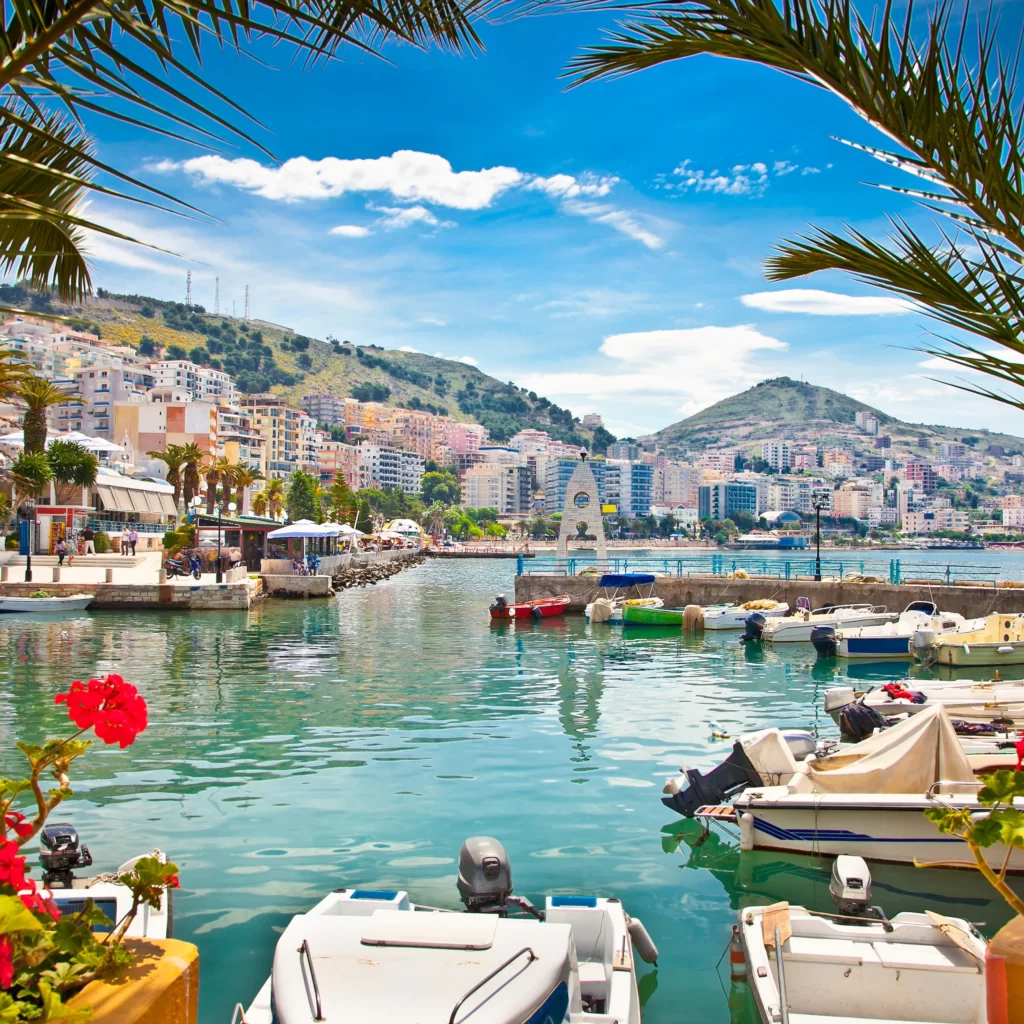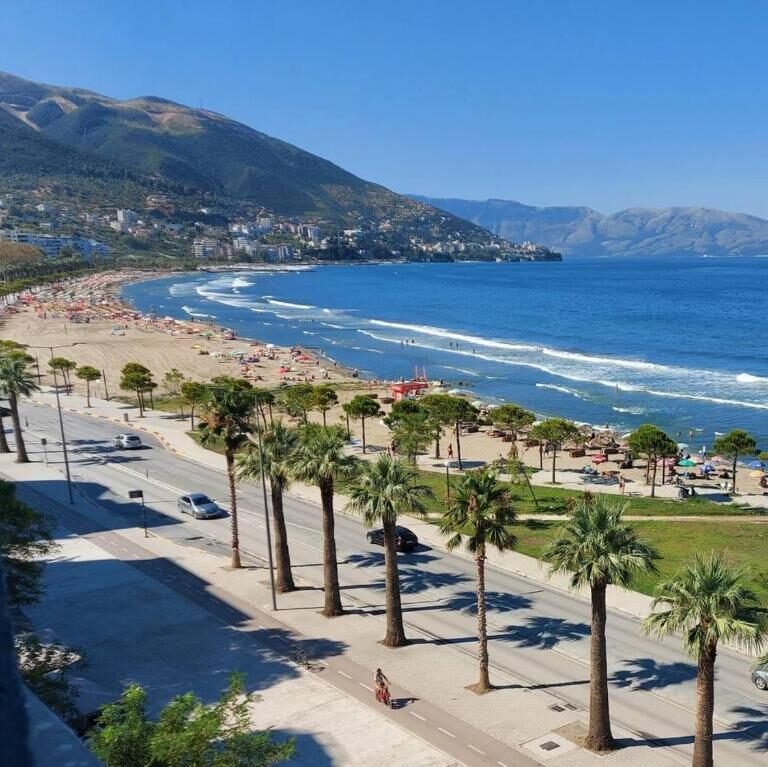

Vlorë (/ˈvlɔːrə/ VLOR-ə,[7][8] Albanian: [ˈvlɔɾə]; Albanian definite form: Vlora[c]) is the third most populous city of the Republic of Albania and seat of Vlorë County and Vlorë Municipality. Located in southwestern Albania, Vlorë sprawls on the Bay of Vlorë and is surrounded by the foothills of the Ceraunian Mountains along the Albanian Adriatic and Ionian Sea Coasts. It experiences a Mediterranean climate, which is affected by the Ceraunian Mountains and the proximity to the Mediterranean Sea.
The coastal area of Vlorë was one of those Illyrian sites that had experienced pre-urban activity beginning from the 11th–10th centuries BCE. The area was colonized by Ancient Greeks. A large fortified port-town that was inhabited from the 6th century BCE to the 2nd century AD is placed, now partially submerged, in Triport, northwest of present-day Vlorë. Substantial port activity in this site occurred from at least the archaic period to the medieval period. It has been suggested that a transfer of the ancient city from the site of Triport to the site of modern Vlorë occurred. The center of the modern city features archaeological remains dating from late antiquity. Aulon, from which the modern city took its name, appears in historial sources starting form the 2nd century CE. It was conquered at different periods throughout history by Romans, Byzantines, Normans, Venetians and Ottomans.
Between the 18th and 19th centuries, the Albanians gathered both spiritual and intellectual strength for national consciousness, which conclusively led to the Albanian Renaissance. Vlorë played an instrumental role in Albanian Independence as an epicenter for the founders of modern Albania, who signed the Declaration of Independence on 28 November 1912 at the Assembly of Vlorë.
Vlorë is one of the most significant cities of southern Albania and the region of Labëria which is traditionally noted for its culture, traditions and folklore. Vlorë is served by the Port of Vlorë, the SH8 highway, and the A2 motorway, collectively representing part of the Adriatic–Ionian Corridor and the Pan-European Corridor VIII.
The coastal area of Vlorë was one of those Illyrian sites that had experienced pre-urban activity beginning from the 11th–10th centuries BCE.[18] During the period of Euboean colonization of the area (early 8th century BC) the bay of Vlorë was associated with several Heroic traditions and the foundation of several settlements there,[19] as the toponym Aulon suggest which is also known in local Eubean toponimity.[20]
Due to its strategic position on the Adriatic Sea, especially the Bay of Vlorë, which forms a natural harbor, Vlorë occupied a significant place in classical antiquity as a base for trade by many peoples. Vlorë is considered one of the oldest cities in Albania and the region.[d] In the Archaic era, the area was colonized by Ancient Greeks, who are traditionally believed to have founded Orikos, Thronion and Aulon on these shores.[21] A large fortified port-town that was inhabited from the 6th century BCE to the 2nd century AD is placed, now partially submerged, in Triport, northwest of present-day Vlorë. It was delimited by three walls, the first of which dating back to the late 6th century BCE.[22] The port activity in this site lasted from at least the archaic period to the medieval period.[23] It has been suggested that a transfer of the ancient city from the site of Triport to the site of modern Vlorë occurred. The center of the modern city features walls dating from the 4th to the 10th centuries CE, as well as a wall, a quadrangular tower and ruins of a huse with ceramics dating back to the 3rd–4th centuries and to the 6th-7th centuries CE.[24]
The archaeological site of Triport has been identified with ancient Thronion or Aulon.[25] Thronion was attested by Pausanias (2nd century CE) as a Locrian–Euboean colony, but also by a dedication on a monument erected in Olympia, both accounts reporting that Apollonia conquered the city around 450 BCE. Aulon, from which Vlorë took its name, was mentioned for the first time by Ptolemy (2nd century CE) among the towns of the Illyrian Taulantii.[26] Carl Patsch proposed the first location of Aulon in Triport being then transferred to the current location of Vlora, and Pierre Cabanes proposed the location of Thronion in Triport; those identifications are not in contradiction with each other.[27] Other geographical documents, such as the Tabula Peutingeriana and Hierocles‘ Synecdemus, also mention Aulon. The city served as an important port of the Roman Empire, when it was part of Epirus Nova.[28][29]
Aulon (Avlona) became an episcopal see in the 5th century. Among the known bishops are Nazarius in 458 and Soter in 553 (Daniele Farlati, Illyricum sacrum, VII, 397–401). The diocese at that time belonged to the papal Pentarchy. In 733, it was annexed with the eastern Illyricum, to the Patriarchate of Constantinople, and yet it is not mentioned in any Notitiae Episcopatuum of that Church. The bishopric had probably been suppressed for though the Bulgarians had been in possession of this country for some time, Avlona is not mentioned in the “Notitiae episcopatuum” of the Bulgarian Archbishopric of Ohrid.
During the Roman period, a Latin see was established and Eubel (Hierarchia catholica medii aevi, I, 124) mentions several of its bishops.[28]
